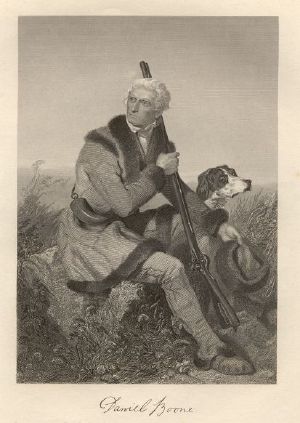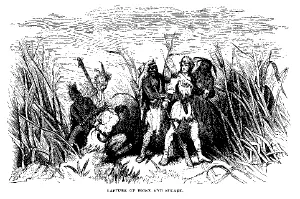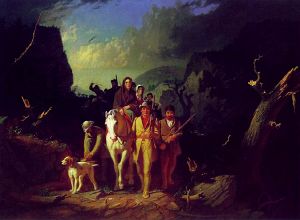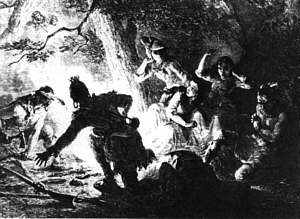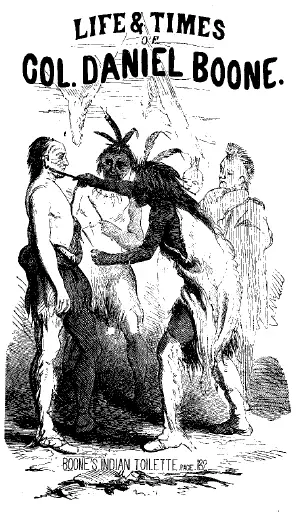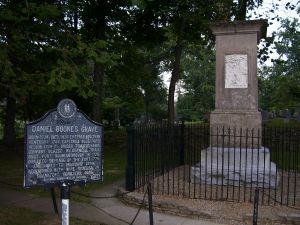Daniel Boone
Daniel Boone (October 22, 1734 – September 26, 1820) was an American frontiersman whose wilderness exploits made him one of the first folk heroes of the United States. Boone is remembered for his exploration and settlement of what is now the state of Kentucky, a territory west of the Appalachian Mountains and a natural boundary of the burgeoning English colonies along the Eastern seaboard. Boone was a consummate woodsman, respected by Native Americans for his hunting and trapping skills but also for his personal integrity. In 1775 Boone blazed the Wilderness Road through the Cumberland Gap and into Kentucky, despite resistance from native inhabitants for whom the lands were traditional hunting grounds. Boone founded Boonesborough, one of the first English-speaking settlements beyond the Appalachians, and before the end of the eighteenth century, more than 200,000 people entered Kentucky by following the route marked by the frontiersman.[1] This westward expansion would continue unchecked until pioneers reached the Pacific, and newly settled lands were absorbed to comprise the current continental United States.
Boone was a militia officer during the American Revolutionary War (1775–1783), which in Kentucky was fought primarily between settlers and British-allied American Indians. Boone was captured by Shawnees in 1778 and adopted into the tribe, but he escaped and continued to help defend the Kentucky settlements. He was elected to the first of his three terms in the Virginia General Assembly during the war, and fought in the Battle of Blue Licks in 1782, one of the last battles of the American Revolution. Boone worked as a surveyor and merchant after the war, and in 1799 resettled in Missouri, where he spent his final years.
Boone remains an iconic, if imperfectly remembered, figure in American history. He was a legend in his own lifetime, especially after an account of his adventures was published in 1784, making him famous in America and Europe. Throughout his life he followed a simple code in his relations with Indians, based on his Quaker upbringing: "Always meet them frankly and fearlessly, showing not the slightest sign of fear or trepidation. By kind acts and just treatment, keep on the friendly side of them."[2]After his death, he was frequently the subject of tall tales and works of fiction. His adventures—real and legendary—were influential in creating the archetypal hero of American folklore.[3] Boone's simple creed can be summed up in a letter he wrote not long before his death in 1820:
"All the Relegan I have [is] to Love and fear god, believe in Jeses Christ, do all the good to my Neighbor and my Self that I Can, and Do as little harm as I Can help,and trust on gods marcy for the rest and I believe god never made a man of my prisipel to be lost."[4]
Youth
Boone was born on October 22, 1734. Because the Gregorian calendar was adopted during Boone's lifetime, his birth date is sometimes given as November 2, 1734 (the "New Style" date), although Boone always used the October date. He was the sixth of eleven children in a family of Quakers. His father, Squire Boone (1696–1765), had immigrated to Pennsylvania from the small town of Bradninch, England in 1713. Squire Boone's parents George and Mary Boone followed their son to Pennsylvania in 1717. In 1720, Squire, who worked primarily as a weaver and a blacksmith, married Sarah Morgan (1700–1777), whose family members were Quakers from Wales. In 1731, the Boones built a log cabin in the Oley Valley, now the Daniel Boone Homestead in Berks County, Pennsylvania, where Daniel was born.[5]
Boone spent his early years on what was then the western edge of the Pennsylvania frontier. There were a number of American Indian villages nearby—the pacifist Pennsylvania Quakers generally had good relations with Indians—but the steady growth of the white population was compelling many Indians to relocate further west. Boone received his first rifle in 1747 and picked up hunting skills from local whites and Indians, beginning his lifelong love of hunting. Folk tales often emphasized Boone's skills as a hunter. In one story, the young Boone is hunting in the woods with some other boys. The scream of a panther scatters the boys, except for Boone, who calmly cocks his squirrel gun and shoots the animal through the heart just as it leaps at him. As with so many tales about Boone, the story is likely apocryphal, but it was told so often that it became part of the popular image of the man.[6]
In Boone's youth, his family became a source of controversy in the local Quaker community. In 1742, Boone's parents were compelled to publicly apologize after their eldest child Sarah married a "worldling," or non-Quaker, while she was visibly pregnant. When Boone's oldest brother Israel also married a "worldling" in 1747, Squire Boone stood by his son and was therefore expelled from the Quakers, although his wife continued to attend monthly meetings with her children. Perhaps as a result of this controversy, in 1750 Squire sold his land and moved the family to North Carolina. Daniel Boone did not attend church again, although he always considered himself a Christian and had all of his children baptized. The Boones eventually settled on the Yadkin River, in what is now Davie County, North Carolina, about two miles (3 km) west of Mocksville.[7]
Because he spent so much time hunting in his youth, Boone received little formal education. According to one family tradition, a schoolteacher once expressed concern over Boone's education, but Boone's father was unconcerned, saying "let the girls do the spelling and Dan will do the shooting…." Boone received some tutoring from family members, though his spelling remained unorthodox. Historian John Mack Faragher cautions that the folk image of Boone as semiliterate is misleading, however, arguing that Boone "acquired a level of literacy that was the equal of most men of his times." Boone regularly took reading material with him on his hunting expeditions—the Bible and Gulliver's Travels were favorites—and he was often the only literate person in groups of frontiersmen. Boone would sometimes entertain his hunting companions by reading to them around the evening campfire.[8]
Hunter, husband, and soldier
As a young man, Boone served with the British military during the French and Indian War (1754–1763), a struggle for control of the land beyond the Appalachian Mountains. In 1755, he was a wagon driver in General Edward Braddock's attempt to drive the French out of the Ohio Country, which ended in disaster at the Battle of the Monongahela. Boone returned home after the defeat, and on August 14, 1755, he married Rebecca Bryan, a neighbor in the Yadkin Valley. The couple initially lived in a cabin on his father's farm. They would eventually have ten children.
In 1759, a conflict erupted between British colonists and Cherokee Indians, their former allies in the French and Indian War. After the Yadkin Valley was raided by Cherokees, many families, including the Boones, fled to Culpeper County, Virginia. Boone served in the North Carolina militia during this "Cherokee Uprising", and was separated from his wife for about two years. According to one story, Boone was gone for so long that Rebecca assumed he was dead, and began a relationship with his brother Edward ("Ned"), giving birth to daughter Jemima in 1762. Upon his return, the story goes, Boone was understanding and did not blame Rebecca. Whether the tale is true or not is uncertain, but Boone raised Jemima as his own child.[9]
| I can't say as ever I was lost, but I was bewildered once for three days. —Daniel Boone[10] |
Boone's chosen profession also made for long absences from home. He supported his growing family in these years as a market hunter. Almost every autumn, Boone would go on "long hunts," which were extended expeditions into the wilderness lasting weeks or months. Boone would go on long hunts alone or with a small group of men, accumulating hundreds of deer skins in the autumn, and then trapping beaver and otter over the winter. The long hunters would return in the spring and sell their take to commercial fur traders. In this business, buckskins came to be known as "bucks," which is the origin of the American slang term for "dollar."[11]
Frontiersmen often carved messages on trees or wrote their names on cave walls, and Boone's name or initials have been found in many places. One of the best-known inscriptions was carved into a tree in present Washington County, Tennessee which reads "D. Boon Cilled a. Bar [killed a bear] on [this] tree in the year 1760." A similar carving is preserved in the museum of the Filson Historical Society in Louisville, Kentucky, which reads "D. Boon Kilt a Bar, 1803." However, because Boone always spelled his name with the final "e," these particular inscriptions may be forgeries, part of a long tradition of phony Boone relics.[12]
In the mid-1760s, Boone began to look for a new place to settle. The population was growing in the Yadkin Valley after the end of the French and Indian War, which inevitably decreased the amount of game available for hunting. This meant that Boone had difficulty making ends meet; he was often taken to court for nonpayment of debts, and he sold what land he owned to pay off creditors. After his father died in 1765, Boone traveled with a group of men to Florida, which had become British territory after the end of the war, to look into the possibility of settling there. According to a family story, Boone purchased land in Pensacola, but Rebecca refused to move so far away from friends and family. The Boones instead moved to a more remote area of the Yadkin Valley, and Boone began to hunt westward into the Blue Ridge Mountains.[13]
Kentucky
Boone first reached Kentucky in the fall of 1767 when on a long hunt with his brother Squire Boone, Jr. While on the Braddock expedition years earlier, Boone had heard about the fertile land and abundant game of Kentucky from fellow wagoner John Findley, who had visited Kentucky to trade with American Indians. In 1768, Boone and Findley happened to meet again, and Findley encouraged Boone with more tales of Kentucky. At the same time, news had arrived about the Treaty of Fort Stanwix, in which the Iroquois had ceded their claim to Kentucky to the British. This, as well as the unrest in North Carolina due to the Regulator movement, likely prompted Boone to extend his exploration.[14]
In May 1769, Boone began a two-year hunting expedition in Kentucky. On December 22, 1769, he and a fellow hunter were captured by a party of Shawnees, who confiscated all of their skins and told them to leave and never return. The Shawnees had not signed the Stanwix treaty, and since they regarded Kentucky as their hunting ground, they considered American hunters there to be poachers. Boone, however, continued hunting and exploring Kentucky until his return to North Carolina in 1771, and returned to hunt there again in the autumn of 1772.
On September 25, 1773, Boone packed up his family and, with a group of about 50 emigrants, began the first attempt by British colonists to establish a settlement in Kentucky. Boone was still an obscure hunter and trapper at the time; the most prominent member of the expedition was William Russell, a well-known Virginian and future brother-in-law of Patrick Henry. On October 9, Boone's oldest son James and a small group of men and boys who had left the main party to retrieve supplies were attacked by a band of Delawares, Shawnees, and Cherokees. Following the Treaty of Fort Stanwix, American Indians in the region had been debating what do to about the influx of settlers. This group had decided, in the words of historian John Mack Faragher, "to send a message of their opposition to settlement…." James Boone and William Russell's son Henry were captured and gruesomely tortured to death. The brutality of the killings sent shockwaves along the frontier, and Boone's party abandoned their expedition.[15]
The massacre was one of the first events in what became known as Dunmore's War, a struggle between Virginia and primarily Shawnees of the Ohio Country for control of what is now West Virginia and Kentucky. In the summer of 1774, Boone volunteered to travel with a companion to Kentucky to notify surveyors there about the outbreak of war. The two men journeyed more than 800 miles in two months in order to warn those who had not already fled the region. Upon his return to Virginia, Boone helped defend colonial settlements along the Clinch River, earning a promotion to captain in the militia as well as acclaim from fellow citizens. After the brief war, which ended soon after Virginia's victory in the Battle of Point Pleasant in October 1774, Shawnees relinquished their claims to Kentucky.[16]
Following Dunmore's War, Richard Henderson, a prominent judge from North Carolina, hired Boone to travel to the Cherokee towns in present North Carolina and Tennessee and inform them of an upcoming meeting. In the 1775 treaty, Henderson purchased the Cherokee claim to Kentucky in order to establish a colony called Transylvania. Afterwards, Henderson hired Boone to blaze what became known as the Wilderness Road, which went through the Cumberland Gap and into central Kentucky. Along with a party of about 30 workers, Boone marked a path to the Kentucky River, where he established Boonesborough. Other settlements, notably Harrodsburg, were also established at this time. Despite occasional Indian attacks, Boone returned to the Clinch Valley and brought his family and other settlers to Boonesborough on September 8, 1775.[17]
American Revolution
Violence in Kentucky increased with the outbreak of the American Revolutionary War (1775–1783). Native Americans who were unhappy about the loss of Kentucky in treaties saw the war as a chance to drive out the colonists. Isolated settlers and hunters became the frequent target of attacks, convincing many to abandon Kentucky. By late spring of 1776, fewer than 200 colonists remained in Kentucky, primarily at the fortified settlements of Boonesborough, Harrodsburg, and Logan's Station.[18]
On July 14, 1776, Boone's daughter Jemima and two other teenage girls were captured outside Boonesborough by an Indian war party, who carried the girls north towards the Shawnee towns in the Ohio country. Boone and a group of men from Boonesborough followed in pursuit, finally catching up with them two days later. Boone and his men ambushed the Indians while they were stopped for a meal, rescuing the girls and driving off their captors. The incident became the most celebrated event of Boone's life. James Fenimore Cooper created a fictionalized version of the episode in his classic book The Last of the Mohicans (1826).[19]
In 1777, Henry Hamilton, the British Lieutenant Governor of Canada, began to recruit American Indian war parties to raid the Kentucky settlements. On April 24, Shawnees led by Chief Blackfish attacked Boonesborough. Boone was shot in the ankle while outside the fort, but he was carried back inside the fort amid a flurry of bullets by Simon Kenton, a recent arrival at Boonesborough. Kenton became Boone's close friend as well as a legendary frontiersman in his own right.
While Boone recovered, Shawnees kept up their attacks outside Boonesborough, destroying the surrounding cattle and crops. With the food supply running low, the settlers needed salt to preserve what meat they had, and so in January 1778 Boone led a party of 30 men to the salt springs on the Licking River. On February 7, 1778, when Boone was hunting meat for the expedition, he was surprised and captured by warriors led by Blackfish. Because Boone's party was greatly outnumbered, he convinced his men to surrender rather than put up a fight.
Blackfish wanted to continue to Boonesborough and capture it, since it was now poorly defended, but Boone convinced him that the women and children were not hardy enough to survive a winter trek. Instead, Boone promised that Boonesborough would surrender willingly to the Shawnees the following spring. Boone did not have an opportunity to tell his men that he was bluffing in order to prevent an immediate attack on Boonesborough, however. Boone pursued this strategy so convincingly that many of his men concluded that he had switched his loyalty to the British.
Boone and his men were taken to Blackfish's town of Chillicothe where they were made to run the gauntlet. As was their custom, the Shawnees adopted some of the prisoners into the tribe to replace fallen warriors; the remainder were taken to Hamilton in Detroit. Boone was adopted into a Shawnee family at Chillicothe, perhaps into the family of Chief Blackfish himself, and given the name Sheltowee ("Big Turtle"). On June 16, 1778, when he learned that Blackfish was about to return to Boonesborough with a large force, Boone eluded his captors and raced home, covering the 160 miles to Boonesborough in five days on horseback and, after his horse gave out, on foot.[20]
During Boone's absence, his wife and children (except for Jemima) had returned to North Carolina, fearing that he was dead. Upon his return to Boonesborough, some of the men expressed doubts about Boone's loyalty, since after surrendering the salt-making party, he had apparently lived quite happily among the Shawnees for months. Boone responded by leading a preemptive raid against the Shawnees across the Ohio River, and then by helping to successfully defend Boonesborough against a 10-day siege led by Blackfish, which began on September 7, 1778.
After the siege, Captain Benjamin Logan and Colonel Richard Callaway—both of whom had nephews who were still captives surrendered by Boone—brought charges against Boone for his recent activities. In the court-martial that followed, Boone was found "not guilty" and was even promoted after the court heard his testimony. Despite this vindication, Boone was humiliated by the court-martial, and he rarely spoke of it.[21]
After the trial, Boone returned to North Carolina in order to bring his family back to Kentucky. In the autumn of 1779, a large party of emigrants came with him, including the grandfather of Abraham Lincoln. Rather than remain in Boonesborough, Boone founded the nearby settlement of Boone's Station. Boone began earning money at this time by locating good land for other settlers. Transylvania land claims had been invalidated after Virginia created Kentucky County, and so settlers needed to file new land claims with Virginia. In 1780, Boone collected about $20,000 in cash from various settlers and traveled to Williamsburg to purchase their land warrants. While he was sleeping in a tavern during the trip, the cash was stolen from his room. Some of the settlers forgave Boone the loss; others insisted that he repay the stolen money, which took him several years to do.
A popular image of Boone which emerged in later years is that of the backwoodsman who had little affinity for "civilized" society, moving away from places like Boonesborough when they became "too crowded." In reality, however, Boone was a leading citizen of Kentucky at this time. When Kentucky was divided into three Virginia counties in November 1780, Boone was promoted to lieutenant colonel in the Fayette County militia. In April 1781, Boone was elected as a representative to the Virginia General Assembly, which was held in Richmond. In 1782, he was elected sheriff of Fayette County.[22]
Meanwhile, the American Revolutionary War continued. Boone joined General George Rogers Clark's invasion of the Ohio country in 1780, fighting in the Battle of Piqua on August 7. In October, when Boone was hunting with his brother Ned, Shawnees shot and killed Ned. Apparently thinking that they had killed Daniel Boone, the Shawnees beheaded Ned and took the head home as a trophy. In 1781, Boone traveled to Richmond to take his seat in the legislature, but British dragoons under Banastre Tarleton captured Boone and several other legislators near Charlottesville. The British released Boone on parole several days later. During Boone's term, Cornwallis surrendered at Yorktown in October 1781, but the fighting continued in Kentucky unabated. Boone returned to Kentucky and in August 1782 fought in the Battle of Blue Licks, in which his son Israel was killed. In November 1782, Boone took part in another Clark expedition into Ohio, the final major campaign of the war.
Businessman on the Ohio
After the Revolution, Boone resettled in Limestone (renamed Maysville, Kentucky in 1786), then a booming Ohio River port. In 1787, he was elected to the Virginia state assembly as a representative from Bourbon County. In Maysville, he kept a tavern and worked as a surveyor, horse trader, and land speculator. He was initially prosperous, owning seven slaves by 1787, a relatively large number for Kentucky at the time, which was dominated by small farms rather than large plantations. Boone became something of a celebrity while living in Maysville: in 1784, on Boone's 50th birthday, historian John Filson published The Discovery, Settlement And present State of Kentucke, a book which included a chronicle of Boone's adventures.[23]
Although the Revolutionary War had ended, the border war with American Indians north of the Ohio River soon resumed. In September 1786, Boone took part in a military expedition into the Ohio Country led by Benjamin Logan. Back in Limestone, Boone housed and fed Shawnees who were captured during the raid and helped to negotiate a truce and prisoner exchange. Although the Northwest Indian War escalated and would not end until the American victory at the Battle of Fallen Timbers in 1794, the 1786 expedition was the last time Boone saw military action.[24]
Boone began to have financial troubles while living in Maysville. According to the later folk image, Boone the trailblazer was too unsophisticated for the civilization which followed him and which eventually defrauded him of his land. Boone was not the simple frontiersman of legend, however: he engaged in land speculation on a large scale, buying and selling claims to tens of thousands of acres. These ventures ultimately failed because of the chaotic nature of land speculation in frontier Kentucky, as well as Boone's faulty investment strategy and his lack of ruthless business instincts.[25]
Frustrated with the legal hassles that went with land speculation, in 1788 Boone moved upriver to Point Pleasant, Virginia (now West Virginia). There he operated a trading post and occasionally worked as a surveyor's assistant. When Virginia created Kanawha County in 1789, Boone was appointed lieutenant colonel of the county militia. In 1791, he was elected to the Virginia legislature for the third time. He contracted to provide supplies for the Kanawha militia, but his debts prevented him from buying goods on credit, and so he closed his store and returned to hunting and trapping.
In 1795, he and Rebecca moved back to Kentucky, living in present Nicholas County on land owned by their son, Daniel Morgan Boone. The next year, Boone applied to Isaac Shelby, the first governor of the new state of Kentucky, for a contract to widen the Wilderness Road into a wagon route, but the governor did not respond and the contract was awarded to someone else. Meanwhile, lawsuits over conflicting land claims continued to make their way through the Kentucky courts. Boone's remaining land claims were sold off to pay legal fees and taxes, but he no longer paid attention to the process. In 1798, a warrant was issued for Boone's arrest after he ignored a summons to testify in a court case, although the sheriff never found him. That same year Kentucky named Boone County in his honor.
Missouri
In 1799, Boone moved out of the United States to Missouri, which was then part of Spanish Louisiana. The Spanish, eager to promote settlement in the sparsely populated region, did not enforce the legal requirement that all immigrants had to be Catholics. Boone, looking to make a fresh start, emigrated with much of his extended family to what is now St. Charles County. The Spanish governor appointed Boone "syndic" (judge and jury) and commandant (military leader) of the Femme Osage district. The many anecdotes of Boone's tenure as syndic suggest that he sought to render fair judgments rather than to strictly observe the letter of the law.
Boone served as syndic and commandant until 1804, when Missouri became part of the United States following the Louisiana Purchase. Because Boone's land grants from the Spanish government had been largely based on verbal agreements, he once again lost his land claims. In 1809, he petitioned Congress to restore his Spanish land claims, which was finally done in 1814. Boone sold most of this land to repay old Kentucky debts. When the War of 1812 came to Missouri, Boone's sons Daniel Morgan Boone and Nathan Boone took part, but by that time Boone was too old for militia duty.
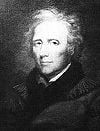
Boone spent his final years in Missouri, often in the company of children and grandchildren. He hunted and trapped as often as his failing health allowed. According to one story, in 1810 or later Boone went with a group on a long hunt as far west as the Yellowstone River, a remarkable journey at his age, if true. Other stories of Boone around this time have him making one last visit to Kentucky in order to pay off his creditors, although some or all of these tales may be folklore. American painter John James Audubon claimed to have gone hunting with Boone in the woods of Kentucky around 1810. Years later, Audubon painted a portrait of Boone, supposedly from memory, although skeptics have noted the similarity of this painting to the well-known portraits by Chester Harding. Boone's family insisted that Boone never returned to Kentucky after 1799, although some historians believe that Boone visited his brother Squire near Kentucky in 1810 and have therefore reported Audubon's story as factual.[26]
Boone died on September 26, 1820, at Nathan Boone's home on Femme Osage Creek. He was buried next to Rebecca, who had died on March 18, 1813. The graves, which were unmarked until the mid-1830s, were near Jemima (Boone) Callaway's home on Tuque Creek, about two miles (3 km) from present day Marthasville, Missouri. In 1845, the Boones' remains were disinterred and reburied in a new cemetery in Frankfort, Kentucky. Resentment in Missouri about the disinterment grew over the years, and a legend arose that Boone's remains never left Missouri. According to this story, Boone's tombstone in Missouri had been inadvertently placed over the wrong grave, but no one had corrected the error. Boone's Missouri relatives, displeased with the Kentuckians who came to exhume Boone, kept quiet about the mistake and allowed the Kentuckians to dig up the wrong remains. There is no contemporary evidence that this actually happened, but in 1983, a forensic anthropologist examined a crude plaster cast of Boone's skull made before the Kentucky reburial and announced that it might be the skull of an African American. Black slaves were also buried at Tuque Creek, so it is possible that the wrong remains were mistakenly removed from the crowded graveyard. Both the Frankfort Cemetery in Kentucky and the Old Bryan Farm graveyard in Missouri claim to have Boone's remains.[27]
Cultural legacy
| Many heroic actions and chivalrous adventures are related of me which exist only in the regions of fancy. With me the world has taken great liberties, and yet I have been but a common man. —Daniel Boone[28] |
Daniel Boone remains an iconic figure in American history, although his status as an early American folk hero and later as a subject of fiction has tended to obscure the actual details of his life. The general public remembers him as a hunter, pioneer, and "Indian-fighter," even if they are uncertain when he lived or exactly what he did. Many places in the United States are named for him, including the Daniel Boone National Forest, the Sheltowee Trace Trail, and Boone County, Missouri. His name has long been synonymous with the American outdoors. For example, the Boone and Crockett Club was a conservationist organization founded by Theodore Roosevelt in 1887, and the Sons of Daniel Boone was the precursor of the Boy Scouts of America.
Emergence as a legend
Boone emerged as a legend in large part because of John Filson's "The Adventures of Colonel Daniel Boon," part of his book The Discovery, Settlement And present State of Kentucke. First published in 1784, Filson's book was soon translated into French and German, and made Boone famous in America and Europe. Based on interviews with Boone, Filson's book contained a mostly factual account of Boone's adventures from the exploration of Kentucky through the American Revolution. However, because the real Boone was a man of few words, Filson invented florid, philosophical dialogue for this "autobiography." Subsequent editors cut some of these passages and replaced them with more plausible—yet still spurious—ones. Often reprinted, Filson's book established Boone as one of the first popular heroes of the United States.[29]
Like John Filson, Timothy Flint also interviewed Boone, and his Biographical Memoir of Daniel Boone, the First Settler of Kentucky (1833) became one of the bestselling biographies of the nineteenth century. Flint greatly embellished Boone's adventures, doing for Boone what Parson Weems did for George Washington. In Flint's book, Boone fought hand-to-hand with a bear, escaped from Indians by swinging on vines (like Tarzan would later do), and so on. Although Boone's family thought the book was absurd, Flint greatly influenced the popular conception of Boone, since these tall tales were recycled in countless dime novels and books aimed at young boys.[30]
Symbol and stereotype
Thanks to Filson's book, in Europe Boone became a symbol of the "natural man" who lives a virtuous, uncomplicated existence in the wilderness. This was most famously expressed in Lord Byron's epic poem Don Juan (1822), which devoted a number of stanzas to Boone, including this one:
- Of the great names which in our faces stare,
- The General Boon, back-woodsman of Kentucky,
- Was happiest amongst mortals any where;
- For killing nothing but a bear or buck, he
- Enjoyed the lonely vigorous, harmless days
- Of his old age in wilds of deepest maze.[31]
Byron's poem celebrated Boone as someone who found happiness by turning his back on civilization. In a similar vein, many folk tales depicted Boone as a man who migrated to more remote areas whenever civilization crowded in on him. In a typical anecdote, when asked why he was moving to Missouri, Boone supposedly replied, "I want more elbow room!" Boone rejected such an interpretation of his life, however. "Nothing embitters my old age," he said late in life, like "the circulation of absurd stories that I retire as civilization advances…."[32]
Existing simultaneously with the image of Boone as a refugee from society was, paradoxically, the popular portrayal of him as civilization's trailblazer. Boone was celebrated as an agent of Manifest Destiny, a pathfinder who tamed the wilderness, paving the way for the extension of American civilization. In 1852, critic Henry Tuckerman dubbed Boone "the Columbus of the woods," comparing Boone's passage through the Cumberland Gap to Christopher Columbus's voyage to the New World. In popular mythology, Boone became the first to explore and settle Kentucky, opening the way for countless others to follow. In fact, other Americans had explored and settled Kentucky before Boone, as debunkers in the twentieth century often pointed out, but Boone came to symbolize them all, making him what historian Michael Lofaro called "the founding father of westward expansion".[33]
In the nineteenth century, when Native Americans were being displaced from their lands and confined on reservations, Boone's image was often reshaped into the stereotype of the belligerent, Indian-hating frontiersman which was then popular. In John A. McClung's Sketches of Western Adventure (1832), for example, Boone was portrayed as longing for the "thrilling excitement of savage warfare." Boone was transformed in the popular imagination into someone who regarded Indians with contempt and had killed scores of the "savages." The real Boone disliked bloodshed, however. According to historian John Bakeless, there is no record that Boone ever scalped Indians, unlike other frontiersmen of the era. Boone once told his son Nathan that he was certain of having killed only one Indian, during the battle at Blue Licks, although he believed that others may have died from his bullets in other battles. Even though Boone had lost two sons in wars with Indians, he respected Indians and was respected by them. In Missouri, Boone often went hunting with the very Shawnees who had captured and adopted him decades earlier. Some nineteenth century writers regarded Boone's sympathy for Indians as a character flaw and therefore altered his words to conform to contemporary attitudes.[34]
Fiction
Boone's adventures, real and mythical, formed the basis of the archetypal hero of the American West, popular in nineteenth century novels and twentieth century films. The main character of James Fenimore Cooper's Leatherstocking Tales, the first of which was published in 1823, bore striking similarities to Boone; even his name, Nathaniel Bumppo, echoed Daniel Boone's name. The Last of the Mohicans (1826), Cooper's second Leatherstocking novel, featured a fictionalized version of Boone's rescue of his daughter. After Cooper, other writers developed the Western hero, an iconic figure which began as a variation of Daniel Boone.[35]
In the twentieth century, Boone was featured in numerous comic strips, radio programs, and films, where the emphasis was usually on action and melodrama rather than historical accuracy. These are little remembered today; probably the most noteworthy is the 1936 film Daniel Boone, with George O'Brien playing the title role. The Daniel Boone television series, ran from 1964 to 1970. In the popular theme song for the series, Boone was described as follows:
- Daniel Boone was a man,
- Yes, a big man!
- He was brave, he was fearless
- And as tough as a mighty oak tree!
- From the coonskin cap on the top of ol' Dan
- To the heel of his rawhide shoe;
- The rippin'est, roarin'est, fightin'est man
- The frontier ever knew![36]
The song did not describe the real Daniel Boone, who was not a big man and did not wear a coonskin cap. This was because Fess Parker, the tall actor who played Boone, was essentially reprising his role as Davy Crockett from an earlier series. That Boone could be portrayed as a Crockett, another American frontiersman with a very different persona, was another example of how Boone's image could be reshaped to suit popular tastes.[37]
Notes
- ↑ John Mack Faragher. Daniel Boone: The Life and Legend of an American Pioneer. (New York: Holt, 1992), 351.
- ↑ Faragher, 300
- ↑ For overview of Boone as early folk hero and American icon, as well as his enduring fame and the confusion of myth and history, see Michael Lofaro. Daniel Boone: An American Life. (Lexington, KY: University Press of Kentucky, 2003), 180–83.
- ↑ Faragher, 312
- ↑ For Boone's use of October date, see Michael Bakeless, Daniel Boone: Master of the Wilderness. (Original 1939) reprinted University of Nebraska Press, 1989), 7.
- ↑ Faragher, Daniel Boone, 9.
- ↑ Faragher, Daniel Boone, 25–27; Bakeless, Master of the Wilderness, 16–17. For baptizing children, see Faragher, Daniel Boone, 311.
- ↑ Faragher, Daniel Boone, 16–17, 55–6, 83.
- ↑ For the story about Jemima's birth, see Faragher, 58–62. Faragher notes that Lyman Draper collected the information but did not put it in his manuscript.; Bakeless, 29 mentions only that, "There are some very queer—and probably slanderous—tales about Rebecca herself"
- ↑ Faragher, 65.
- ↑ For market hunting, see Bakeless, 38–39.
- ↑ For doubts about tree carvings, see Faragher, 57–58; Belue's notes in Draper, 163, 286; Lawrence Elliott. The Long Hunter: A New Life of Daniel Boone. (New York: Reader's Digest Press, 1976), 12. For historians who do not doubt the tree carvings, see Lofaro, 18; Bakeless, 33. Faragher and Belue generally question traditional stories more than Bakeless, Elliott, and Lofaro.
- ↑ Faragher, Daniel Boone, 62–66.
- ↑ Faragher, 69–74. According to some versions of the story, Findley specifically sought out Boone in 1768, but Faragher believes it more likely that their second meeting was by chance.
- ↑ Faragher, 89–96, quote on 93.
- ↑ For Boone in Dunmore's War, see Lofaro, 44–49; Faragher, 98–106.
- ↑ When exactly Henderson hired Boone has been a matter of speculation by historians. Some have argued that Boone's first expeditions into Kentucky might have been financed by Henderson in exchange for information about potential places for settlement, while Boone's descendants believed Henderson did not hire Boone until 1774. For doubts that Henderson hired Boone before 1774, see Faragher, 74–76, 348.
- ↑ Faragher, 130.
- ↑ For Boone's influence on James Fenimore Cooper, see Faragher, 331; Bakeless, 139.
- ↑ Boone biographers write that Boone was adopted by the chief, but see Chief Blackfish for doubts.
- ↑ For court-martial, see Faragher, 199–202; Lofaro, 105–106.
- ↑ Faragher, 206.
- ↑ Faragher, 235–237.
- ↑ For border war and prisoner exchanges, see Faragher, 249–258. Most Boone biographers tell a story of Blue Jacket, the Shawnee chief, escaping while in Boone's custody in Maysville, and raise the possibility that Boone intentionally let the chief escape because the two men were friends. According to the scholarly biography of Blue Jacket, however, the chief escaped at a later time: see John Sugden. Blue Jacket: Warrior of the Shawnees. (University of Nebraska Press, 2000), 82.
- ↑ For analysis of Boone's land speculation failures, see Faragher, 245–248.
- ↑ For Yellowstone, see Faragher, 295. For doubts about Audubon's tale, see Faragher, 308–310; Randell Jones. In the Footsteps of Daniel Boone. , 222. For historians who report Audubon's story without doubts, see Lofaro, 161–166; Bakeless, 398–399.
- ↑ For burial controversy, see Faragher, 354–362; Jones, Footsteps, 227–230.
- ↑ Faragher, 302.
- ↑ Faragher, 4–7; Lofaro, 180.
- ↑ Faragher, 323–324.
- ↑ Faragher, 328.
- ↑ Faragher, 302, 325–326.
- ↑ Faragher, 321–322, 350–352; Lofaro, 181–182.
- ↑ Bakeless, 162–162; Faragher, 39, 86, 219, 313, 320, 333.
- ↑ Faragher, 330–333.
- ↑ The complete lyrics of the song can be found online.
- ↑ Faragher, 338–339, 362; Lofaro, 180
ReferencesISBN links support NWE through referral fees
- Bakeless, John. Daniel Boone: Master of the Wilderness. (Original 1939) reprinted University of Nebraska Press, 1989. ISBN 0803260903. The definitive Boone biography of its era, it was the first to make full use of the massive amount of material collected by Lyman Draper.
- Draper, Lyman. The Life of Daniel Boone, edited by Ted Franklin Belue. Mechanicsburg, PA: Stackpole Books, 1998. ISBN 0811709795. Belue's notes provide a modern scholarly perspective to Draper's unfinished nineteenth century biography, which follows Boone's life up to the siege of Boonesborough.
- Elliott, Lawrence. The Long Hunter: A New Life of Daniel Boone. New York: Reader's Digest Press, 1976. ISBN 0883490668.
- Faragher, John Mack. Daniel Boone: The Life and Legend of an American Pioneer. New York: Holt, 1992. ISBN 0805016031. The standard scholarly biography, examines both the history and the folklore.
- Jones, Randell. In the Footsteps of Daniel Boone. NC: John F. Blair, Publ., 2005. ISBN 0895873087. Guide to historical sites associated with Boone.
- Lofaro, Michael. Daniel Boone: An American Life. Lexington, KY: University Press of Kentucky, 2003; ISBN 0813122783. A brief biography, previously published (in 1978 and 1986) as The Life and Adventures of Daniel Boone.
Further reading
- Aron, Stephen. How the West was Lost: The Transformation of Kentucky from Daniel Boone to Henry Clay. Baltimore: Johns Hopkins University Press, 1996. ISBN 080185296X.
- Hammon, Neal O., ed. My Father, Daniel Boone: The Draper Interviews with Nathan Boone. Lexington: University Press of Kentucky, 1999. ISBN 0813121035. An edited version of Draper's interviews with Nathan Boone.
- Slotkin, Richard. Regeneration through Violence: The Mythology of the American Frontier, 1600–1860. Middletown, CT: Wesleyan University Press, 1973. ISBN 0819540552.
- Smith, Henry Nash. Virgin Land: The American West as Symbol and Myth. Cambridge: Harvard University Press, 1950.
- Sugden, John. Blue Jacket: Warrior of the Shawnees. University of Nebraska Press, 2000. ISBN 080329302X
- Sweeney, J. Gray. The Columbus of the Woods: Daniel Boone and the Typology of Manifest Destiny. St. Louis, MO.: Washington University Gallery of Art, 1992. ISBN 0936316144.
- Thwaites, Reuben Gold. Daniel Boone. The first modern biography, originally published in 1902 and often reprinted.
External links
All links retrieved January 24, 2024.
- "The Adventures of Daniel Boone" Filson's "autobiographical" memoir.
- The Discovery, Settlement and present State of Kentucke The entire work by John Filson, including the "Appendix" life of Boone.
- Kentucky gravesite, additional photographs.
Credits
New World Encyclopedia writers and editors rewrote and completed the Wikipedia article in accordance with New World Encyclopedia standards. This article abides by terms of the Creative Commons CC-by-sa 3.0 License (CC-by-sa), which may be used and disseminated with proper attribution. Credit is due under the terms of this license that can reference both the New World Encyclopedia contributors and the selfless volunteer contributors of the Wikimedia Foundation. To cite this article click here for a list of acceptable citing formats.The history of earlier contributions by wikipedians is accessible to researchers here:
The history of this article since it was imported to New World Encyclopedia:
Note: Some restrictions may apply to use of individual images which are separately licensed.
